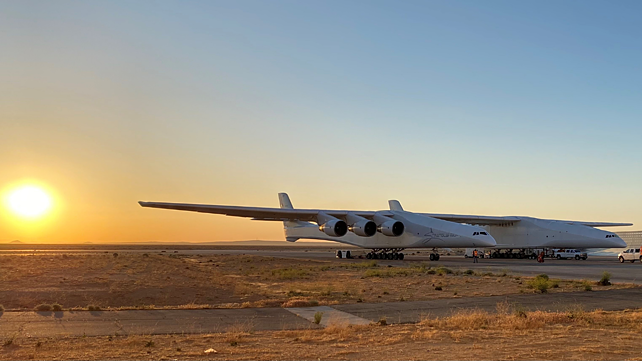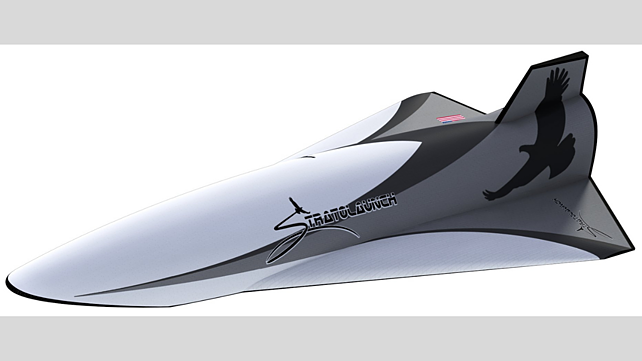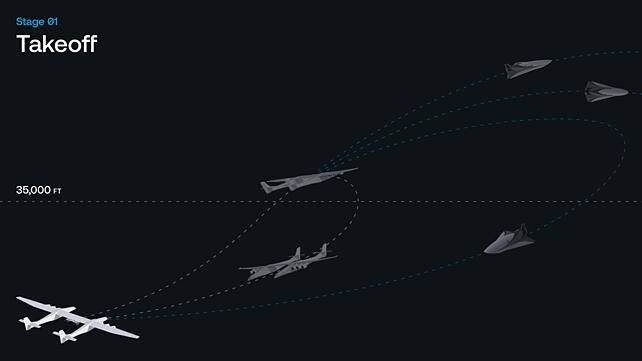
In April, the skies over the dry and inhospitable climate of California’s Mojave Desert witnessed the improbable sight of an ungainly, six-engined aircraft with a wingspan (distance between one wingtip to the other) larger than the length of a football field (360 feet). The incredible aircraft, nicknamed the ‘Roc’ (a mythological bird of enormous size and strength), has a wingspan of 385 feet, nearly twice that of Boeing’s 747 ‘Jumbo Jet’ will provide aerial launch services for hypersonic and aerospace vehicles. The sole flying prototype stayed airborne throughout the test flight for three hours and 14 minutes, attaining a max speed of 330 kmph and an altitude of 14,000 feet.
It was only the second-ever flight for the aircraft built by the US-based high-tech aerospace firm Stratolaunch; Microsoft Co-Founder Paul Allen originally founded it in 2011 to develop a mobile launch system to provide more convenient, reliable, and routine orbital access to space. The Stratolaunch Carrier made its first flight in April 2019 and has a 65-tonne Maximum Take-Off Weight (MTOW) and is 238 feet long.

This unique large aircraft was built by Scaled Composites for Stratolaunch, the former founded by aviation pioneer Burt Rutan. The Stratolaunch airplane features flat-sided fuselages, an all-composite airframe and a primarily straight wing to keep manufacturing costs low. The aircraft uses plenty of components from donor Boeing 747’s such as landing gear, engines and cockpit, flight controls.

Stratolaunch’s unique air-launch system will allow high-speed air vehicles to be deployed over a single mission, and the aircraft can take off and land from a runway just like any other aircraft. It will be able to attain a cruising altitude of 35,000 feet, at which height one or more high-speed vehicles are released, following which the Stratolaunch plane heads back to the runway to reload for its next mission.
A new beginning
Stratolaunch went through a period of transition following Allen’s death in 2018 and reinvented itself to emerge as a firm that would not only provide launch services for hypersonic (speeds at least five times the speed of sound or Mach-5) and aerospace vehicles but also develop its own hypersonic vehicles. The company is now focussing on developing aerospace vehicles and technologies to fulfil several important national needs. This includes the need to significantly advance US hypersonic flight test capabilities and help improve the nation’s ability to design and operate cutting edge hypersonic vehicles.
In May, the company announced that it was making progress with its fleet of hypersonic vehicles and will continue to conduct its carrier aircraft flight tests as it prepares to launch these vehicles from its centre wing. Hypersonic aircraft and their components are exposed to extraordinary levels of heat, vibration, and shock, and Calspan has been contracted to build and test Talon-A models. In February, it announced that test models were ready to begin testing. One of the models will be tested in Calspan’s Transonic Wind Tunnel in Buffalo, NY.

Hypersonic testbed
Stratolaunch’s Talon-A hypersonic flying testbed is an ambitious effort to develop a flexible, fully reusable, autonomous vehicle capable of attaining speeds up to Mach-6 and the company plans to start Talon-A flight tests in 2022. The hypersonic flying testbed will significantly advance US hypersonic capabilities and improve the nation’s ability to design/operate cutting-edge hypersonic vehicles. It will perform hypersonic flights over 1-minute durations throughout flight tests, following which it will glide back before making an autonomous, horizontal landing on a conventional runway. Stratolaunch’s Talon-A’s slender, low-drag form can undertake sustained manoeuvring flight in the atmosphere and provide a reliable test environment for hypersonic research, experiments, and enabling operational missions. The Talon A will be powered by a SL-1 rocket engine and be launched mid-air from the Stratolaunch Carrier plane for its initial tests. Talon-A will be used for the defence and commercial sector and academia, which can contract for payload capacity for space or earth applications.
Images courtesy: Stratolaunch.